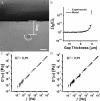Extending vaterite microviscometry to ex vivo blood vessels by serial calibration
- PMID: 22254166
- PMCID: PMC3255340
- DOI: 10.1364/BOE.3.000037
Extending vaterite microviscometry to ex vivo blood vessels by serial calibration
Abstract
The endothelial glycocalyx layer is a ~2 µm thick glycosaminoglycan rich pericellular matrix expressed on the luminal surface of vascular endothelial cells, which has implications in vessel mechanics and mechanotransduction. Despite its role in vascular physiology, no direct measurement has of yet been made of vessel glycocalyx material properties. Vaterite microviscometry is a laser tweezers based microrheological method, which has been previously utilized to measure the viscosity of linear and complex fluids under flow. This form of microrheology has until now relied on complete recollection of the forward scattered light. Here we present a novel method to extend vaterite microviscometry to relatively thick samples. We validate our method and its assumptions and measure the apparent viscosity as a function of distance from the vascular endothelium. We observe a differential response in conditions designed to preserve the EGL in comparison to those designed to collapse it.
Keywords: (140.7010) Laser trapping; (160.1435) Biomaterials; (170.4520) Optical confinement and manipulation.
2011 Optical Society of America
Figures



Similar articles
-
The Molecular Structure of the Endothelial Glycocalyx Layer (EGL) and Surface Layers (ESL) Modulation of Transvascular Exchange.Adv Exp Med Biol. 2018;1097:29-49. doi: 10.1007/978-3-319-96445-4_2. Adv Exp Med Biol. 2018. PMID: 30315538 Review.
-
Implications Enzymatic Degradation of the Endothelial Glycocalyx on the Microvascular Hemodynamics and the Arteriolar Red Cell Free Layer of the Rat Cremaster Muscle.Front Physiol. 2018 Mar 16;9:168. doi: 10.3389/fphys.2018.00168. eCollection 2018. Front Physiol. 2018. PMID: 29615916 Free PMC article.
-
Microviscometry reveals reduced blood viscosity and altered shear rate and shear stress profiles in microvessels after hemodilution.Proc Natl Acad Sci U S A. 2004 Jul 6;101(27):10060-5. doi: 10.1073/pnas.0402937101. Epub 2004 Jun 25. Proc Natl Acad Sci U S A. 2004. PMID: 15220478 Free PMC article.
-
Normal endothelium.Handb Exp Pharmacol. 2006;(176 Pt 1):1-40. doi: 10.1007/3-540-32967-6_1. Handb Exp Pharmacol. 2006. PMID: 16999215 Review.
-
The structure and function of the endothelial glycocalyx layer.Annu Rev Biomed Eng. 2007;9:121-67. doi: 10.1146/annurev.bioeng.9.060906.151959. Annu Rev Biomed Eng. 2007. PMID: 17373886 Review.
Cited by
-
In situ calibration of position detection in an optical trap for active microrheology in viscous materials.Opt Express. 2017 Feb 6;25(3):1746-1761. doi: 10.1364/OE.25.001746. Opt Express. 2017. PMID: 29519028 Free PMC article.
References
-
- Vink H., Duling B. R., “Identification of distinct luminal domains for macromolecules, erythrocytes, and leukocytes within mammalian capillaries,” Circ. Res. 79(3), 581–589 (1996). - PubMed
